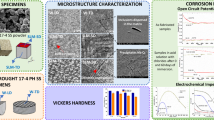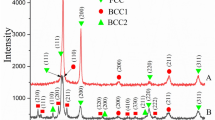Abstract
Crystallographic and fractographic studies have been carried out on hydrogen charged purified iron and on iron-silicon alloys with silicon contents up to 3 pct. The specimens could be cracked by cathodically charging with hydrogen even without the application of an external stress. An experimental technique was developed which enabled the exposure of the fracture surface formed purely by hydrogen charging, and to contrast this with an adjacent mechanically induced fracture surface. In the case of purified iron, hydrogen induced cracks are found to occur on potential slip planes whereas in the case of iron-3 pct silicon, the crack follows the observed cleavage plane. Intermediate silicon content alloys showed transitional behavior. In agreement with the variation of crack plane in the alloys, the fracture surface appearances was also drastically different, reflecting the change in intrinsic toughness with alloy content. The observed transition from slip plane cracking to cleavage plane cracking was found to occur near a silicon content of 0.7 pct. The observed behavior is discussed in terms of how the intrinsic toughness of the ironbased lattice affects how hydrogen-induced cracks are formed.
Similar content being viewed by others
References
C.D. Beachem:Met. Tram., 1972, vol. 3, p. 437.
F. Terasaki and F. Nakasato:Proceedings of Conf. on Mechanism of Delayed Fracture Caused by Hydrogen, p. 165, Tokyo, Japan, 1975.
A. S. Tetelman and W. D. Robertson:Trans. TMS-AIME, 1962, vol. 224, p. 775.
A. S. Tetelman and W. D. Robertson:Acta Met., 1963, vol. 11, p. 415.
M. Gell and W.D. Robertson:Acta Met., 1966, vol. 14, p. 481.
N. P. Allen, B. E. Hopkins, and J. E. McLennan:Proc. Roy. Soc. (London), 1956, A234,p. 221.
E. Schmid and W. Boas:Kristallplastizitat, p. 199, Springer, Berlin, 1935.
I. M. Bernstein:Met. Trans., 1970, vol. 1, p. 3143.
I. M. Bernstein:Mater. Sci. Eng., 1970, vol. 6, p. 1.
K. Kitajima:Proceedings of Conf. on Mechanism of Delayed Fracture Caused by Hydrogen, p. 35, Tokyo, Japan, 1975.
Y. Kikuta, T. Araki, and T. Kuroda: Osaka University, Osaka, Japan, unpublished research, 1974.
C. Ouchi and I. M. Bernstein: Carnegie-Mellon University, Pa., unpublished research, 1974.
F. Nakasato and I. M. Bernstein: Abstract Bulletin, TMS-AIME Fall Meeting, p. 2, Niagara Falls, New York, 1976.
M. Gell, J. P. Briant, and W. D. Robertson:Trans. TMS-AIME, 1967, vol. 239, p.813.
F. Terasaki, F. Nakasato, and S. Okamoto:Tetsu-To-Hagane, 1973, vol. 59, p. S574.
F. Terasaki and S. Okamoto:Tetsu-To-Hagane, 1974, vol. 60, p. S576.
W. C. Leslie, R. J. Sober, S. G. Babcock, and S. J. Green:Trans. ASM, 1969, vol. 62, p. 690.
W. C. Leslie:Met. Trans., 1972, vol. 3, p. 5.
C. S. Barrett:Structure of Metals, McGraw-Hill, New York, 1943, p. 292.
M. Gell: Ph.D. Thesis, Yale University, 1965.
A. H. Cottrell:Trans. TMS-AIME, 1958, vol. 212, p. 192.
C. Zapffe and C. Sims:Trans. AIME, 1941, vol. 145, p. 225.
C. Zapffe:Trans. ASM, 1947, vol. 39,p. 190.
A. S. Tetelman:Fracture of Solids, p. 671, Gordon and Breach, 1963.
I. M. Bernstein, R. Garber, and G. M. Pressouyre:Effect of Hydrogen on Behavior of Materials, A. W. Thompson and I. M. Bernstein, eds., p. 37, TMS-AIME, 1976.
I. M. Bernstein and A. W. Thompson:Mechanisms of Environment Sensitive Cracking of Materials, P. R. Swann and F. P. Ford, eds., p. 412, The Metals Society, 1978.
G. M. Pressouyre: Ph.D. Thesis, Carnegie-Mellon University, 1977, (also ONR report NR 036-099-7).
G. H. Koch, A. J. Bursle, and E. N. Pugh:Met. Trans. A, 1978, vol. 9A, p. 179
Author information
Authors and Affiliations
Additional information
Formerly at Carnegie-Mellon University.
An erratum to this article is available at http://dx.doi.org/10.1007/BF02663426.
Rights and permissions
About this article
Cite this article
Nakasato, F., Bernstein, I.M. Crystallographic and fractographic studies of hydrogen- induced cracking in purified iron and iron- silicon alloys. Metall Trans A 9, 1317–1326 (1978). https://doi.org/10.1007/BF02652256
Received:
Issue Date:
DOI: https://doi.org/10.1007/BF02652256




